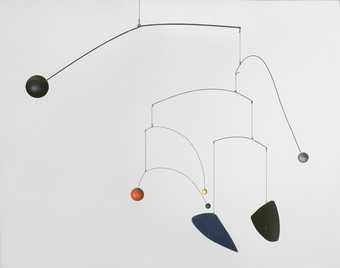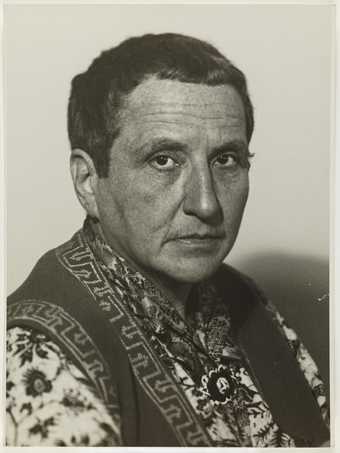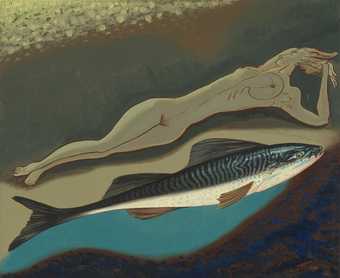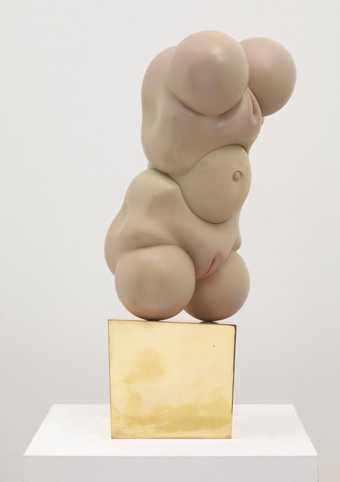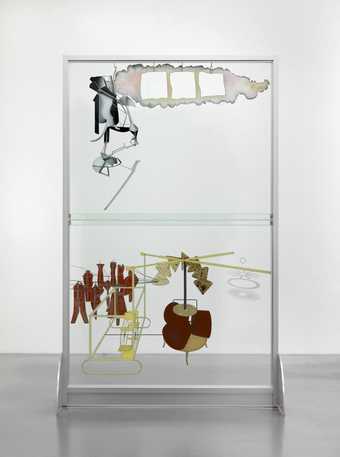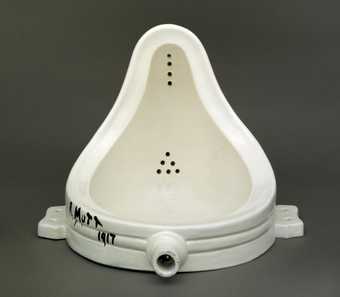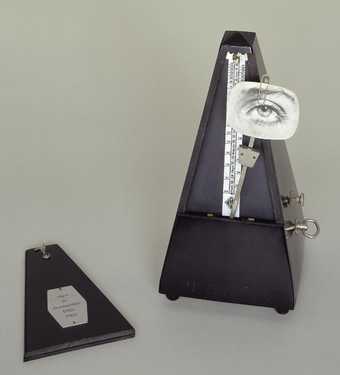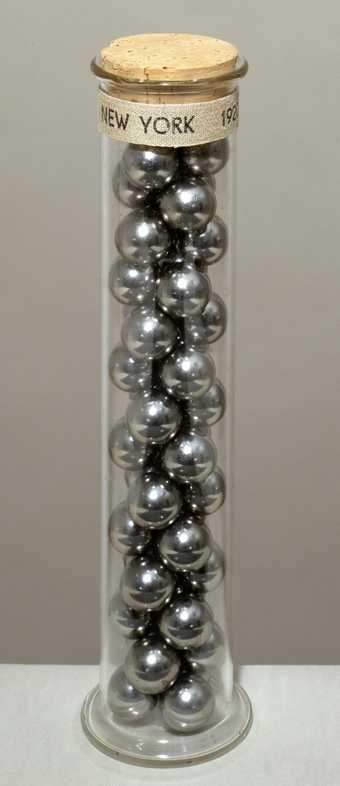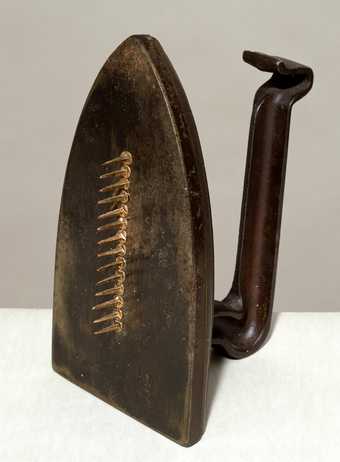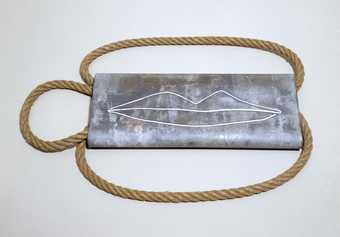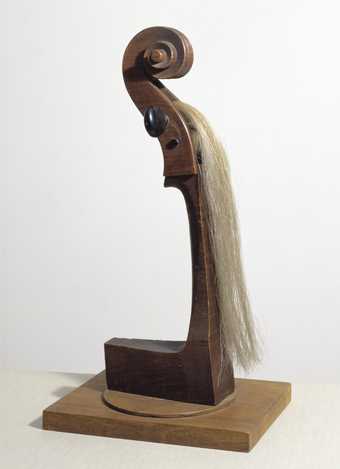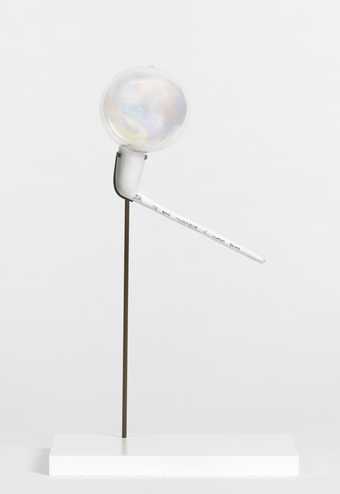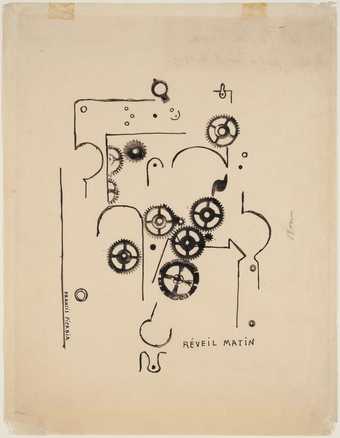Not on display
- Artist
- Man Ray 1890–1976
- Medium
- Sewing machine, wool and string
- Dimensions
- Object: 355 × 605 × 335 mm
- Collection
- Tate
- Acquisition
- Purchased 2003
- Reference
- T07957
Summary
L’Enigme d’Isidore Ducasse, 1920, remade 1972, consists of a sewing machine, wrapped in a blanket and tied with string. Man Ray’s idea of using a sewing machine was inspired by a simile used by the French writer, Isidore Ducasse (1809-87), better known as the Comte de Lautréamont, ‘Beautiful as the accidental encounter, on a dissecting table, of a sewing machine and an umbrella’. It was a phrase that was greatly admired by the writers in Paris with whom Man Ray was close friends and who formed the nucleus of the Paris dada and later surrealist groups. They saw it as paradigmatic of a new type of surprising imagery, as well as replete with disguised sexual symbolism. (The umbrella was interpreted as a male element, the sewing machine as a female element, and the dissecting table as a bed.). Man Ray’s wrapped object, however, was a mystery, and suggested not so much a sewing machine as some utterly undefined, and therefore potentially more disturbing, presence. The word ‘enigma’ in the title echoed some of the titles of paintings by Giorgio de Chirico (1888-1978), also much admired by the proto-surrealist group, while its image of something wrapped and hidden can be seen as a forerunner of images of disguised or concealed objects by the Belgian surrealist René Magritte (1898-1967), as well as the later wrapped works of Christo (born 1935).
A photograph of the original version of the work was reproduced on the first page of the first issue of the surrealist periodical La Révolution surréaliste in December 1924. The accompanying text was a manifesto statement about the importance of dreams within surrealism. It would seem that the photograph of this mysterious object had been selected to encapsulate the surrealists’ vision of what lay beyond rational apprehension and the norms of daily reality. In 1932 the surrealist painter Salvador Dalí (1904-1989) recalled this particular image when he wrote about the early days of the movement: ‘The semi-darkness of the first phase of surrealist experiment would disclose some headless dummies and a shape wrapped up and tied with string, the latter, being unidentifiable, having seemed very disturbing in one of Man Ray’s photographs (already, then, this suggested other wrapped-up objects which one wanted to identify by touch but finally found could not be identified; their invention, however, came later).’ (‘The Object as Revealed in Surrealist Experimentation’, in Haim Finkelstein, ed. and trans., The Collected Writings of Salvador Dalí, Cambridge 1998, p.237.)
Like so many of Man Ray’s early objects, the original work is lost. It was exhibited, however, at the Exposition surréaliste d’objets at the Galerie Charles Ratton, Paris, in 1936. In 1969 the Moderna Museet, Stockholm, made a replica with the artist’s permission. An edition of ten examples, made without using sewing machines, was produced in 1971 by the Galleria Schwarz, Milan. According to Man Ray’s assistant, Lucien Treillard, Man Ray was dissatisfied with the Schwarz edition and in 1972 he authorized the making of a new piece, using a sewing machine, and intended this example to be an exhibition copy of the work. Treillard assembled and made the work under Man Ray’s instruction, using a Pfaff sewing machine of the period 1920-5 owned by his wife’s grandmother, and a storage blanket and string that were in Man Ray’s studio (letter to Tate, January 2003). The string has been replaced subsequently. According to Treillard, this unique remade piece is closer to the original work than other existing replicas. It is listed in the 1983 Paris catalogue of Man Ray’s objects.
Despite Man Ray’s status as one of the pioneering figures of interwar art, his objects are not particularly widely known. This is largely due to his greater fame as a photographer; but it is also in part due to the complex history of many of his objects. A number of the earliest works were lost or accidentally destroyed (the same is true of many of the early classic objects by his friend Marcel Duchamp, 1887-1968). Others are known primarily as photographs reproduced in surrealist magazines and their status as objects has been obscured by the celebrity of the photographic images. In fact, Man Ray sometimes made objects in order to photograph them, and then discarded them, or reused them in other ways. He also remade some works, thereby creating new originals, and when, in the 1960s and 1970s, there was a greater commercial interest in the objects, he, like Duchamp, arranged for some of his objects to be produced in editions.
In addition to L’Enigme d’Isidore Ducasse, Tate owns a number of other objects by Man Ray. These are New York, 1920, editioned replica 1973 (Tate T07882), Cadeau,
1921, editioned replica 1972 (Tate T07883), Indestructible Object, 1922-3, remade 1933, editioned replica 1965 (Tate T07614), Emak Bakia, 1926, remade 1970 (Tate T07959), Ce qui manque à nous tous, 1927, editioned replica 1962 (Tate T07960), and The Lovers, 1933, editioned replica 1973 (Tate T07958).
Further Reading:
Man Ray: Objets de mon affection, Paris 1983, p.142 number 27, reproduced p.39
Arturo Schwarz, Man Ray: The Rigour of the Imagination, London 1977, p.161-2
Jennifer Mundy
March 2003
Does this text contain inaccurate information or language that you feel we should improve or change? We would like to hear from you.
Display caption
Isidore Ducasse was a nineteenth-century author better known by his pseudonym, the Comte de Lautréamont. This work was inspired by Ducasse’s famous phrase: ‘As beautiful as the chance meeting, on a dissecting table, of a sewing machine and an umbrella’. The Surrealists saw this simile, describing the surprising conjunction of disparate elements, as a model for Surrealist images in art and poetry. Man Ray used a real sewing machine as the wrapped object. The original example, now lost, was exhibited in the 1936 Surrealist exhibition of objects.
Gallery label, November 2012
Does this text contain inaccurate information or language that you feel we should improve or change? We would like to hear from you.
Explore
- emotions, concepts and ideas(16,416)
-
- universal concepts(6,387)
-
- mystery(1,436)
- furnishings(3,081)
-
- blanket(52)
- sewing machine(10)
- string(54)
You might like
-
Alexander Calder Mobile
c.1932 -
Man Ray Gertrude Stein
c.1920–9 -
Man Ray Pisces
1938 -
Hans Bellmer The Doll
1936, reconstructed 1965 -
Marcel Duchamp The Bride Stripped Bare by her Bachelors, Even (The Large Glass)
1915–23, reconstruction by Richard Hamilton 1965–6, lower panel remade 1985 -
Max Ernst Dadaville
c.1924 -
Marcel Duchamp 3 stoppages étalon (3 Standard Stoppages)
1913–14, replica 1964 -
Marcel Duchamp Fountain
1917, replica 1964 -
Man Ray Indestructible Object
1923, remade 1933, editioned replica 1965 -
Man Ray New York
1920, editioned replica 1973 -
Man Ray Cadeau
1921, editioned replica 1972 -
Man Ray The Lovers
1933, editioned replica 1973 -
Man Ray Emak Bakia
1926, remade 1970 -
Man Ray Ce qui manque à nous tous
1927, editioned replica 1973 -
Francis Picabia Alarm Clock
1919


